May 18, 2025
About Hualien
Hualien is a county located on the eastern coast of Taiwan, bordered by the Pacific Ocean to the east and the Central Mountain Range to the west. It is Taiwan’s largest county, covering an area of approximately 4,628 square kilometers, and is renowned for its stunning natural landscapes and rich indigenous culture.
Hualien offers a unique blend of natural beauty, cultural richness, and outdoor adventure. Whether you’re exploring the majestic Taroko Gorge, experiencing indigenous traditions, or enjoying the serene coastal landscapes, Hualien provides an unforgettable experience for travelers seeking to connect with Taiwan’s diverse heritage and stunning environments.
Geography and Climate
Hualien’s terrain is predominantly mountainous, with the Central Mountain Range running through the county. This geographical setting provides breathtaking views and a variety of outdoor activities. The county experiences a tropical rainforest climate, characterized by significant rainfall throughout the year. Average temperatures range from 18°C in January to 28°C in July .
World-Class Natural Attractions
Taroko National Park: Famous for its marble gorges, towering cliffs, and the Liwu River, Taroko is one of Taiwan’s most iconic natural landmarks.
East Coast National Scenic Area: This area offers beautiful coastal landscapes, including beaches and cliffs, ideal for sightseeing and photography.
Yushan National Park: Home to Yushan (Jade Mountain), the highest peak in Taiwan, attracting hikers and nature enthusiasts.
Indigenous Culture
Hualien has a significant indigenous population, with communities such as the Amis, Atayal, Truku, and Bunun residing in the area. The county celebrates its indigenous heritage through various festivals and cultural events, providing visitors with opportunities to experience traditional music, dance, and crafts.
Economy and Development
The economy of Hualien is primarily based on tourism, agriculture, and fishing. The county has been promoting its natural beauty and cultural heritage to attract both domestic and international visitors. Efforts are underway to enhance infrastructure and services to support sustainable tourism and economic growth.
Taiwan Tourist Shuttle Bus in Hualien
Click image to view full size
Things to Do in Taroko Gorge
Taroko Gorge is one of Taiwan’s most awe-inspiring natural wonders, and its network of trails offers hikers an unforgettable way to explore this breathtaking landscape. Located in the eastern part of the island, Taroko Gorge is famous for its towering marble cliffs, deep ravines, and lush forests, all of which can be experienced from a variety of well-maintained trails.
Whether you’re a seasoned hiker looking for a challenge or a beginner wanting a more leisurely walk, the trails in Taroko Gorge cater to all levels, showcasing the region’s stunning beauty from every angle.
From the short and easy hikes like the Lushui Trail, which provides sweeping views of the gorge, to the more adventurous hikes such as the Zhuilu Old Trail, known for its cliffside paths and dramatic vistas, each trail in Taroko Gorge offers something unique.
The diversity of the trails means that hikers can explore different aspects of the gorge, from its rich indigenous history to its unique flora and fauna. The well-maintained paths and well-marked signs make it easy to navigate, allowing visitors to enjoy the hike at their own pace and take in the extraordinary surroundings.
Read Taroko Gorge Trails
15 Trail Recommendations in Taroko National Park
1. Shakadang Trail
Length: 4.4 km round trip
Difficulty: Easy
Highlights: Follows the Shakadang River with striking blue water and marble boulders. Great for beginners and families.
2. Zhuilu Old Trail (Permit Required)
Length: 6 km round trip to the cliff section
Difficulty: Moderate to hard
Highlights: Taiwan’s most thrilling cliffside trail. Epic views 500m above the Liwu River.
3. Lushui Trail
Length: 2.2 km one-way
Difficulty: Easy to moderate
Highlights: Forest trail with educational signs, historical sites, and gorge viewpoints.
4. Baiyang Trail
Length: 2.1 km one-way
Difficulty: Easy
Highlights: Passes through tunnels to Baiyang Waterfall and Water Curtain Cave. Family-friendly.
5. Eternal Spring Shrine Trail
Length: 1.3 km round trip
Difficulty: Moderate
Highlights: Leads to a shrine commemorating highway workers, with a beautiful waterfall backdrop.
6. Yanzikou Trail / Swallow Grotto
Length: 1.4 km round trip
Difficulty: Easy
Highlights: Swallows, marble cliffs, and roaring river. Helmets often required due to falling rocks.
7. Tunnel of Nine Turns Trail
Length: 700 m one-way
Difficulty: Easy
Highlights: Short but dramatic. Hugely popular for up-close views of the narrowest section of Taroko Gorge.
8. Dekalun Trail
Length: ~4 km round trip
Difficulty: Moderate
Highlights: Quiet forest trail near Buluowan, with good views of the gorge and native plant life.
9. Dali–Datong Trail
Length: 9.6 km round trip
Difficulty: Moderate to challenging
Highlights: Connects Truku villages. Rich in cultural history and mountain scenery.
10. Buluowan Terrace Trails
Length: ~2 km (loop)
Difficulty: Easy
Highlights: Scenic walk with cultural displays and views over Liwu River.
11. Chongde Trail
Length: ~5 km
Difficulty: Moderate
Highlights: Cliffside views of the Pacific Ocean and mountain backdrops. Less crowded.
12. Huoran Pavilion Trail
Length: ~1.5 km round trip
Difficulty: Moderate
Highlights: Quick trail to a viewpoint overlooking Taroko Gorge. Ideal for sunrise or sunset.
13. Huide Trail
Length: ~4.5 km round trip
Difficulty: Moderate
Highlights: Secluded coastal forest trail with sweeping ocean views.
14. Heren Trail
Length: ~5 km round trip
Difficulty: Moderate
Highlights: Coastal trail with historic remnants and birdwatching opportunities.
15. Changchun Shrine – Bell Tower Trail
Length: ~2.2 km round trip
Difficulty: Moderate
Highlights: Climbs above Eternal Spring Shrine to a peaceful bell tower with views over the gorge.
Things to Do in Hualien
Qingshui Cliff
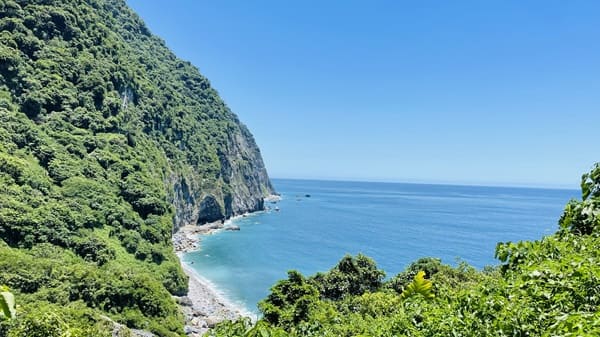
Huide Rest Stop Google Map and Chongde Rest Stop Google Map
You can take in stunning views of Qingshui Cliff from both the Huide Rest Stop and the Chongde Rest Stop, located along the scenic Suhua Highway in Hualien. These spots offer some of the best vantage points to admire the towering cliffs that plunge dramatically into the Pacific Ocean.
At Huide Rest Stop, near the 174.6 km mark of the highway, you’ll find a quiet lookout with sweeping views of the coastline. A short path leads to a stretch of the old highway, giving visitors a chance to enjoy different angles of the cliffside and turquoise sea in a peaceful setting.
Chongde Rest Stop, close to the Chongde Tunnel, offers another incredible view of Qingshui Cliff. There’s a viewing platform and access to Chongde Trail, which leads down to a pebble beach where the cliffs meet the ocean. It’s an especially dramatic spot where the highway seems to disappear into the mountains.
Both rest areas are easy to reach, free to enter, and perfect for a scenic break while exploring Taiwan’s beautiful east coast.
Chongde Beach
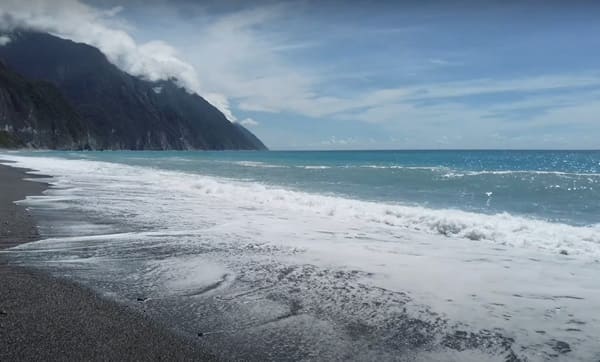
Chongde Beach in Hualien is a peaceful and scenic spot nestled along Taiwan’s dramatic east coast, just off the Suhua Highway near the 175 km mark. Surrounded by towering cliffs and facing the vast Pacific Ocean, this pebble-covered shoreline offers a quiet retreat away from the crowds. It’s perfect for a relaxing walk, watching the waves, or catching a spectacular sunrise. The beach’s natural rock formations and raw, untouched beauty make it a favorite for photographers and nature lovers alike.
Though it’s close to attractions like Qingshui Cliff and Taroko Gorge, Chongde Beach remains relatively low-key, which adds to its charm. There are no facilities directly on the beach, so visitors should come prepared with essentials. Swimming isn’t advised due to strong currents, but the beach’s dramatic setting and calming atmosphere make it an ideal stop for anyone exploring Taiwan’s east coast. It’s easily accessible by car or a short walk from Chongde Train Station, making it a convenient yet serene destination. Google Map
Hualien Railway Culture Park
花蓮鐵道文化園區

The Hualien Railway Culture Park offers visitors a fascinating glimpse into Taiwan’s transportation history, blending heritage preservation with interactive exhibits in a charming outdoor setting. Located in central Hualien City, this former train maintenance depot has been thoughtfully transformed into a cultural hub, where old locomotives, rail tracks, and historical buildings are on display.
It’s an ideal stop for families, train enthusiasts, and history buffs looking to explore a quieter side of Hualien beyond its natural attractions.
Hualien Cultural Creative Industries Park
花蓮文化創意產業園區
The Hualien Cultural and Creative Industries Park is a vibrant cultural hub located in the heart of Hualien City, Taiwan. Spanning 3.3 hectares, this former wine distillery during the Japanese colonial era has been thoughtfully transformed into a dynamic space that blends history with modern creativity. Featuring 26 repurposed factory warehouses, the park hosts a variety of cultural and creative activities, including exhibitions, performances, workshops, and markets.
Visitors can explore art galleries, enjoy live music, participate in hands-on crafts, and savor local cuisine, all within a setting that preserves the site’s historical architecture. Whether you’re an art enthusiast, history buff, or simply looking to experience the local culture, the Hualien Cultural and Creative Industries Park offers a unique and enriching experience.
Hualien Pacific Landscape Park
太平洋公園
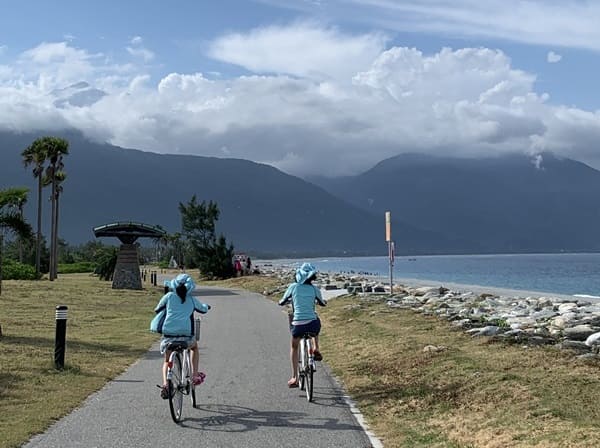
The Hualien Pacific Landscape Park is a vibrant coastal destination in Hualien City, Taiwan, seamlessly blending urban accessibility with natural beauty. Spanning approximately 27 hectares, the park merges the former Nanbin and Beibin Parks into a dynamic space that offers recreational activities, stunning ocean views, and artistic installations.
Visitors can enjoy beach volleyball courts, scenic walking paths, and the park’s centerpiece—a massive 3D mural of a dragon, the largest of its kind in Taiwan. Situated near the Dongdamen Night Market, it’s an ideal spot for both daytime relaxation and evening exploration.
Starbucks Shipping Container Store
星巴克 – 洄瀾門市

The Starbucks Shipping Container Store in Hualien, located in the Ji’an Township, is a unique and innovative café made from repurposed shipping containers. It is Taiwan’s first Starbucks store built using 29 shipping containers, stacked to create a striking two-story structure. Designed by renowned Japanese architect Kengo Kuma, the store incorporates elements of sustainable design, with large windows that allow natural light to flood the space, and the use of wood and glass for a warm and inviting atmosphere.
The exterior features a design inspired by coffee tree leaves and traditional Chinese arches. Inside, visitors can enjoy a modern, eco-friendly space with cultural artwork that reflects the indigenous Amis culture of the region. This store has quickly become a popular photo spot, blending creative architecture with the global Starbucks experience.
Sanzhan Riverside Area
三棧溪戲水區 Google Map
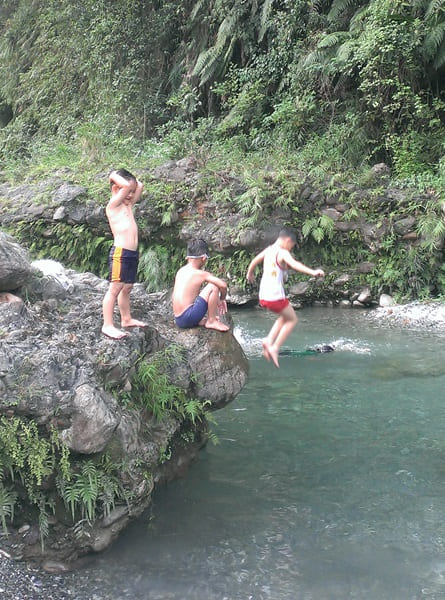
The Sanzhan Riverside Area in Hualien County is a captivating destination nestled within Taroko National Park, offering a blend of adventure and natural beauty. Situated near the Indigenous Truku village of Sanzhan, this area is renowned for its crystal-clear turquoise waters and dramatic landscapes. It’s a popular spot for river tracing, with routes leading to the famed Golden Grotto, a multi-tiered slot canyon that attracts adventure enthusiasts
For those seeking a more relaxed experience, the riverside features several shallow pools perfect for swimming and cooling off during the summer months. The surrounding cliffs and lush greenery create a serene backdrop, making it an ideal destination for nature lovers and outdoor adventurers alike. Whether you’re interested in thrilling river tracing or simply enjoying the tranquil beauty of the area, the Sanzhan Riverside Area offers a memorable experience in Hualien.
Emerald Valley Shuilian Waterfall
翡翠谷水簾瀑布 Google Map
The Emerald Valley Shuilian Waterfall in Hualien County is a serene natural retreat nestled within the Taroko National Park. Accessible via a short hike through a historic Japanese-era tunnel, this hidden gem features a picturesque curtain-like waterfall cascading into a crystal-clear pool, offering a refreshing spot for swimming and relaxation.
Beyond the main waterfall, the valley reveals a series of natural rock pools and tranquil swimming holes, perfect for those seeking a peaceful escape. The surrounding lush greenery and the cool mountain air enhance the area’s charm, making it an ideal destination for nature lovers and adventure enthusiasts alike. Whether you’re interested in a leisurely swim or simply wish to enjoy the scenic beauty, the Emerald Valley Shuilian Waterfall provides a memorable experience in Hualien.
Shapodangxipan Park
砂婆噹溪畔公園 Google Map
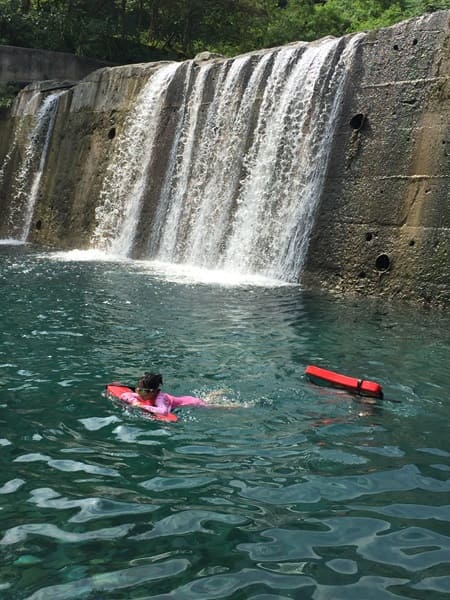
Located near the Shapotang River, Shapotang Riverside Park is famous for its clear river water and lush environment. Visitors can enjoy various outdoor activities such as picnicking, fishing, and leisurely walks along the riverbanks.
The park’s well-maintained trails and scenic viewpoints make it an ideal spot for birdwatching and photography. With its peaceful ambiance and natural beauty, Shapodangxipan Park provides a perfect escape from the hustle and bustle of city life.
Baibao River
白鮑溪 Google Map
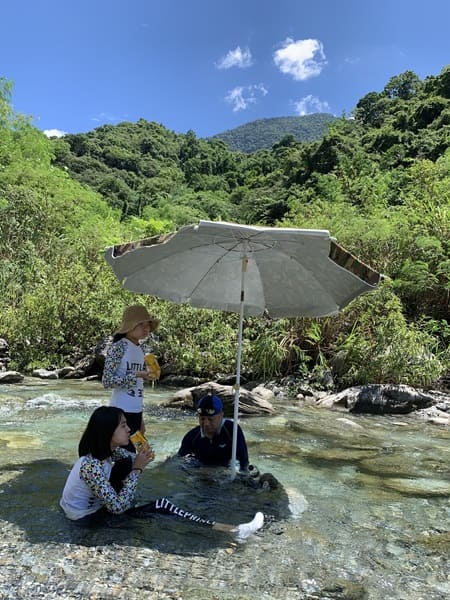
Baibao River in Hualien’s Shoufeng Township is a peaceful natural escape, known for its clear waters and lush surroundings. Flowing down from Mount Mugua, this scenic river is ideal for swimming, river tracing, and enjoying the quiet beauty of the area.
A popular way to experience it is via the Baibao River Bikeway, a 7-kilometer cycling path that winds through greenery and alongside the river, perfect for a relaxing ride or a leisurely walk. Rich in local wildlife and sometimes even hiding jade stones in its riverbed, Baibao River offers a refreshing mix of adventure and tranquility for nature lovers and families alike.
Xiuguluan River
秀姑巒溪泛舟
Xiuguluan River, the longest river on Taiwan’s east coast, flows 104 kilometers from the Central Mountain Range to the Pacific Ocean. It’s best known for its exciting whitewater rafting route between Ruisui and Changhong Bridge, where a series of rapids makes it a top spot for adventure seekers. Along its course, the river winds through beautiful scenery and passes indigenous Amis villages, offering a mix of natural and cultural experiences.
The Xiuguluan River Visitor Center in Ruisui provides useful information on rafting safety, local wildlife, and the region’s heritage. Whether you’re after high-energy water sports or a scenic retreat, the Xiuguluan River is a must-visit destination in Hualien.
Farglory Ocean Park
遠雄海洋公園
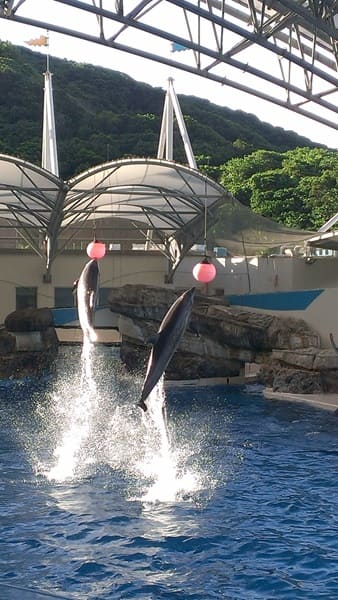
Farglory Ocean Park in Hualien is Taiwan’s first marine-themed amusement park, offering a perfect mix of fun, education, and stunning coastal views. Located in Shoufeng Township, the park spans 51 hectares and features eight exciting areas, including the Dolphin Lagoon, Underwater Kingdom, and Crystal Castle. Visitors can enjoy mesmerizing dolphin and sea lion shows, thrilling rides like the Clear Sky Cable Car, and explore the Marine Mammal Education Center.
The park also focuses on environmental education, partnering with various research institutions to promote marine conservation. Whether you’re looking for adventure, family-friendly attractions, or a deeper understanding of marine life, Farglory Ocean Park has something for everyone.
Yunshanshui Dream Lake
雲山水夢幻湖
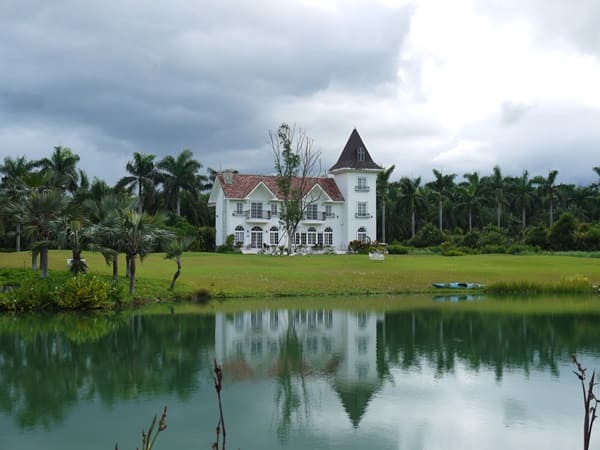
Yunshanshui Dream Lake in Hualien County is a serene and beautiful spot that showcases the natural charm of Taiwan. Located in Shoufeng Township, this 24-hectare lake is known for its calm waters that perfectly mirror the surrounding mountains and seasonal scenery.
Visitors can take peaceful walks around the lake, enjoy paddleboarding, or simply unwind by the water, soaking in the tranquil atmosphere. The area also features a botanical farm with a variety of seasonal flowers and lush plants. Whether you’re looking for a quiet retreat or a picturesque place for photography, Yunshanshui Dream Lake offers a refreshing escape in Hualien’s East Rift Valley.
Liyu Lake
鯉魚潭

Liyu Lake in Hualien County, also known as “Carp Lake,” is the largest inland lake in eastern Taiwan. Located in Shoufeng Township, it spans 104 hectares and offers a scenic environment perfect for outdoor activities. Visitors can enjoy cycling along the 5-kilometer lakeside path or take part in water activities like pedal boating, kayaking, and stand-up paddleboarding.
The lake is also famous for its firefly season, where, from April to May, the area lights up with the glow of thousands of fireflies. With its peaceful ambiance and variety of recreational options, Liyu Lake is an ideal spot for nature lovers and families seeking a relaxing getaway.
Li Chuan Aquafarm
立川漁場
Li Chuan Aquafarm in Hualien’s Shoufeng Township is a popular eco-tourism spot known for its high-quality golden clams and relaxing natural setting. Established in 1971, the farm is surrounded by mountains and nourished by clean spring water, making it ideal for sustainable aquaculture.
Visitors can try hands-on activities like digging for clams, crafting with clam shells, and learning more about aquafarming at the Clam Museum. The on-site restaurant serves fresh, locally sourced seafood, with golden clam dishes being the highlight. Combining fun, food, and education, Li Chuan Aquafarm is a great destination for families and those curious about Taiwan’s local food culture.
Sixty Stone Mountain
六十石山金針花
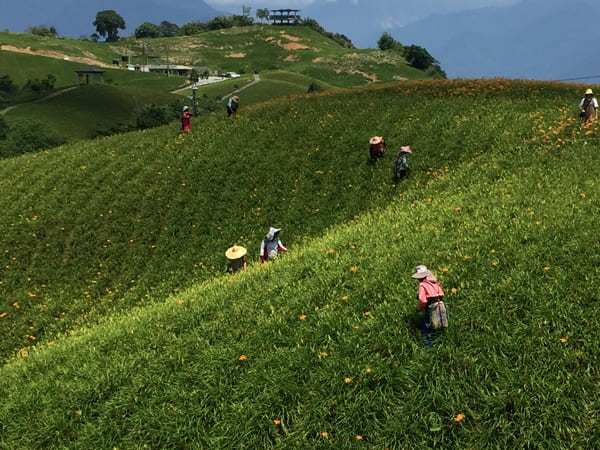
Sixty Stone Mountain, also known as Liushidan Mountain, is a stunning hillside destination in Hualien County, famous for its golden fields of blooming daylilies that blanket the slopes each year from August to September. Located about 800 meters above sea level, it offers panoramic views of the East Rift Valley and is a popular spot for photographers and nature lovers.
The name is said to come from either the high millet yield once produced here or the discovery of 60 large stones during the Japanese era. Visitors can explore scenic trails, take in the vibrant flower fields, and enjoy local Hakka dishes while surrounded by breathtaking mountain scenery.
Daylily Flowers Chihke Mountain
赤柯山金針花
Chihke Mountain in Hualien is a scenic highland known for its stunning display of blooming daylilies that light up the hillsides every summer. Perched between 800 and 1,200 meters in elevation, the mountain turns into a golden wonderland from July through August as fields of daylilies stretch across more than 300 hectares.
These flowers are not only beautiful but also valued for their culinary use, harvested just before they bloom. During the Daylily Season Festival, visitors flock to enjoy the vibrant landscape, sample local Hakka dishes, and take part in cultural activities. With its cool mountain air and breathtaking views, Chihke Mountain is a perfect seasonal retreat for photographers and nature lovers.
Qixingtan Beach
七星潭
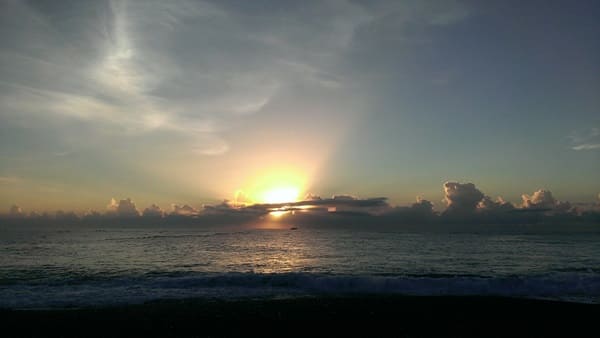
Qixingtan Beach in Hualien is a beautiful coastal gem, known for its crescent-shaped shoreline and smooth pebbles that create a unique atmosphere. The beach gets its name from its resemblance to the Big Dipper constellation, reflecting the area’s rich history—once home to a lake before being filled during the Japanese colonial era to build an airport.
Today, it’s a peaceful spot for visitors to enjoy a relaxing walk along the beach, bike along the coastline, or gaze at the stars under the clear skies. The nearby Chihsing Tan Katsuo Museum also offers a glimpse into the region’s fishing traditions. Whether you’re looking to unwind or explore, Qixingtan Beach is a perfect place to enjoy Hualien’s natural beauty.
48 Highland Military Tunnel
四八高地戰備坑道
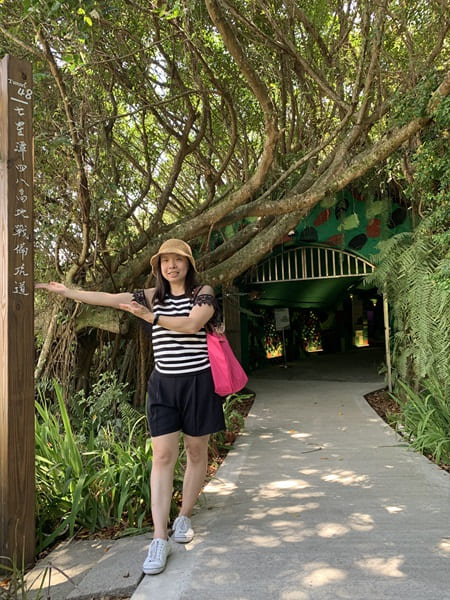
The 48 Highland Military Tunnel in Hualien is a fascinating historical landmark that offers insight into Taiwan’s military past. Built by the Japanese during World War II, the tunnel was part of a defensive system designed to protect the Hualien Port Airfield from enemy attacks. After being closed for many years, it was reopened to the public in 2020, allowing visitors to explore its well-preserved structure and learn about its wartime significance.
Now located within the Mambo Marine Ecological Leisure Park, the site combines history with nature, offering art installations, seasonal flower displays, and a chance to experience the local wildlife. It’s an ideal spot for those interested in both history and nature.
ChiHsin Dry Bonito Museum
七星柴魚博物館
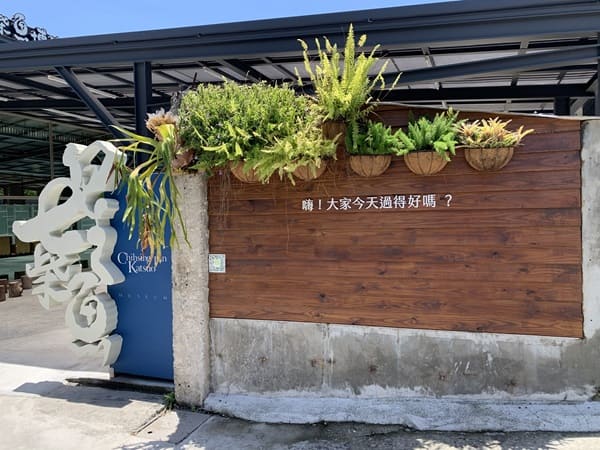
The ChiHsin Dry Bonito Museum in Hualien provides an interesting look into Taiwan’s fishing culture, specifically the traditional process of making dried bonito (katsuobushi). Located in a former Japanese-era fish processing facility, the museum offers visitors a chance to learn about the art of drying bonito, a practice brought from Japan and adapted by local fishermen.Exhibits cover the history of the fishing industry in the ChiHsin area, traditional fishing techniques, and the ecological importance of marine life in the region.
Visitors can also participate in hands-on activities like shaving bonito flakes and making takoyaki. The museum’s shop offers various seafood products, such as bonito flakes and fish cakes, allowing guests to take home a taste of the experience. Located near Qixingtan Beach, it’s a great spot for those interested in Taiwan’s coastal traditions and culinary heritage.
Ruisui Farm
瑞穗牧場
Ruisui Ranch in Hualien County is a picturesque dairy farm located in the lush plains of Ruisui Township. Originally established in 1969 as a papaya farm, it has since transformed into a thriving dairy farm, home to over 300 Holstein cows that produce high-quality milk.
Visitors are welcome to explore the ranch, interact with the cows, and even feed them fresh grass. The on-site café and shop offer a range of delicious dairy products, including fresh milk, milk buns, ice cream, and cheesecakes. With its beautiful mountain views and family-friendly atmosphere, Ruisui Ranch offers a fun and relaxing experience for visitors of all ages.
Tropic of Cancer Marker Park
北回歸線標誌公園
Tropic of Cancer Marker Park in Hualien is an intriguing site that marks the Tropic of Cancer at 23.5°N latitude, the line dividing the tropical and subtropical zones. Located along Provincial Highway 11 in Fengbin Township, the park features a prominent white monument with a slit through which the sun aligns perfectly on the summer solstice, creating a unique shadowless effect at noon.
The park also offers educational displays about the 24 solar terms in Chinese culture and the Four Symbols, representing the four cardinal directions and seasons. With scenic views of both the Pacific Ocean and the Coastal Mountain Range, this peaceful spot is ideal for photography, relaxation, and learning, making it a perfect stop for visitors year-round.
Jingpu Tropic of Cancer Landmark
靜浦北迴歸線界標
The Jingpu Tropic of Cancer Landmark in Hualien marks the Tropic of Cancer at 23.5°N latitude, the dividing line between the tropical and subtropical zones. Located along Provincial Highway 11 in Fengbin Township, this striking white monument features a slit through which sunlight perfectly aligns at noon on the summer solstice, creating a fascinating shadowless moment for visitors.
The site offers a rare chance to witness this natural phenomenon, and with easy access to facilities like parking and restrooms, it’s a popular stop for travelers exploring the East Coast of Taiwan. Additionally, the area is known for its natural beauty, including the nearby Balaeluan Creek, home to diverse wildlife and lush surroundings.
Shitiping Terraced Rocks
石梯坪遊憩風景區
Shitiping Terraced Rocks in Hualien is a stunning coastal site known for its unique geological formations and vibrant marine life. The name “Shitiping,” meaning “stone steps platform,” perfectly describes the expansive, sea-eroded terraces that resemble large stone staircases leading into the Pacific Ocean. This area features a variety of natural wonders, including raised coral reefs, sea arches, and deep sea trenches, all shaped by years of wind and water erosion.
The intertidal zone is rich in marine life, with crabs, starfish, and colorful fish, making it a paradise for nature lovers and photographers. Visitors can explore the area on well-maintained boardwalks, hike up a 17-meter-high cuesta for panoramic views, or even camp to catch a breathtaking sunrise. It’s also an excellent spot for snorkeling and diving, with clear waters and thriving coral reefs. Shitiping offers a unique chance to experience Taiwan’s coastal geology and ecology in a remarkable outdoor setting.
Qingbuzhizi Ancient Trail
親不知子天空步道
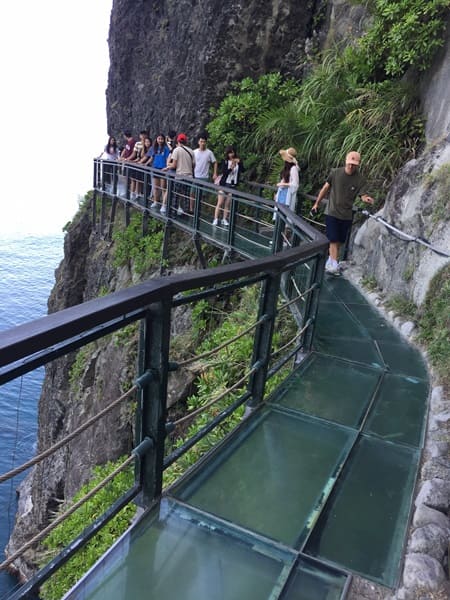
The Qingbuzhizi Ancient Trail in Hualien is a scenic path rich in both natural beauty and indigenous history. Located near the Fengbin Tunnel along Provincial Highway 11, this trail was once a crucial route connecting the Xinshe and Jiqi tribes. The name “Qingbuzhizi,” which translates to “parents don’t know their child,” comes from a poignant legend about a mother losing her child while navigating a dangerous cliffside path.
Today, the trail offers stunning views of the Pacific Ocean and the rugged coastline, highlighted by a 20-meter glass skywalk suspended 40 meters above sea level. Easy to access from the parking area, the trail is open daily, except on Wednesdays, and offers visitors a chance to explore Taiwan’s beautiful landscapes and cultural heritage.
Dashibishan Trail
大石鼻山步道
The Dashibishan Trail in Hualien offers a short but scenic hike with breathtaking views of the Pacific Ocean and the surrounding coastal landscape. Situated near Jiqi Beach along Provincial Highway 11, the trail is about 750 meters long and takes around 15 to 20 minutes to complete. The well-maintained path includes wooden planks and stone steps, making it accessible to most visitors.
Along the trail, there are rest pavilions and informational signs. At the top, you’ll be rewarded with a stunning 360-degree view of the coastline, Jiqi Bay, and the vast ocean. This family-friendly trail is also a great place for birdwatching and soaking in the natural beauty of the area, with a nearby rest stop offering refreshments and even more scenic views.
Baqi Observatory
芭崎休息區

Baqi Observatory in Hualien is a scenic lookout located along Provincial Highway 11, offering stunning panoramic views of the Pacific Ocean and the surrounding coastline. Situated at the 31.5 km mark, the observatory provides a clear view of Jiqi Bay, Guihou Cape, and Xinshe Cliff, creating a breathtaking coastal vista.
The platform is equipped with telescopes for visitors to get a closer look at the scenery. A nearby 100-meter wooden boardwalk leads to a shaded resting area, perfect for relaxing and enjoying the peaceful surroundings. With a small parking lot, restrooms, and a snack shop, Baqi Observatory is an ideal spot for travelers to take a break and soak in the natural beauty of Taiwan’s East Coast.
Hualien Shimen Cave
花蓮石門洞
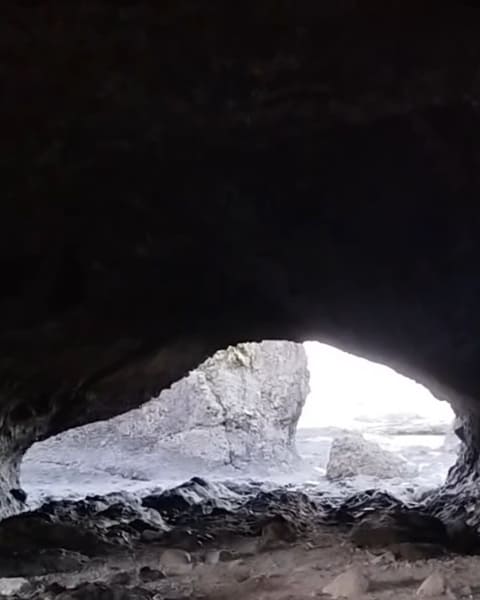
Shimen Cave, also known as “March Cave” due to its unique shape resembling a Nissan March car grill, is a fascinating natural landmark located along the East Coast of Taiwan, at the 60.5 km point on Provincial Highway 11 in Hualien County. This sea-carved arch stands about 5 meters tall and 18 meters wide, with three distinct openings, one of which is beautifully framed by a large banyan tree. The surrounding area is rich in geological features, including sea trenches, potholes, and terraces, making it a perfect spot for nature lovers and photographers.
Visitors can explore the coastal reef, observe marine life, and enjoy breathtaking views of the Pacific Ocean. The Shimen Recreation Area also offers amenities like parking, restrooms, and walking trails, providing a comfortable and educational visit. This site gained even more fame when it was featured in Martin Scorsese’s 2016 film Silence, further highlighting its allure as a must-visit destination along Taiwan’s East Coast.
It is recommended to go during the day when the tide is low.
Nanan Waterfall
南安瀑布
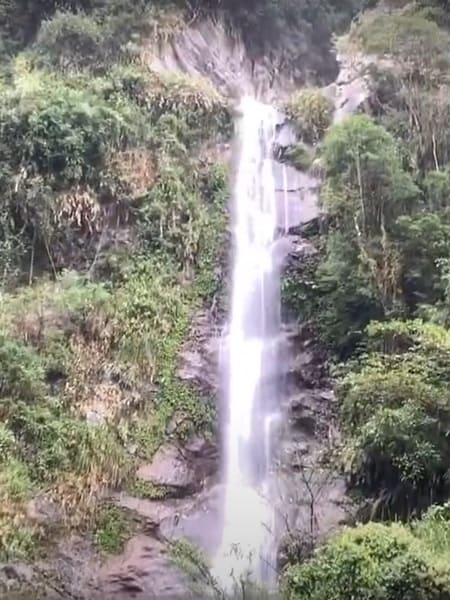
Nanan Waterfall in Hualien County is a stunning natural wonder located in Zhuoxi Township along Route 30. The waterfall cascades down in two distinct tiers, with the upper section falling 20 meters and the lower section plunging 40 meters into a tranquil pool. Originating from the Hualien River’s tributaries, which flow from the eastern slopes of Dalixian Mountain, the waterfall is surrounded by lush forest, making it a great spot for nature lovers and photographers.
A viewing platform near Zhuo’an Bridge provides a perfect vantage point, and the area offers facilities such as restrooms and parking. Nanan Waterfall is also a gateway to the nearby Walami Trail, ideal for those wanting to further explore the mountainous beauty of Hualien.
What to Eat in Hualien
Night Market
Dongdamen Night Market: The largest night market on Taiwan’s east coast. It’s divided into sections based on ethnic cuisines – including Amis, Hakka, and Taiwanese stalls and offers a fun, festive atmosphere every night.
Popular Restaurants
Gong Zheng Bun Store 公正街包子店 Google Map
Gong Zheng Bun Store in Hualien is a must-visit destination for street food lovers, famous for its affordable and satisfying xiao long bao (soup dumplings) and steamed buns. Located on Renai Street, this humble shop regularly draws crowds eager to enjoy its generously sized dumplings, each filled with juicy, flavorful pork and wrapped in thick, chewy dough.
Priced at just NT$5 per piece, these buns offer incredible value without compromising on taste. The store also serves up steamed dumplings that are equally hearty and delicious, often enjoyed with a splash of their signature garlic soy sauce. With its simple charm and consistent quality, Gong Zheng Bun Store is a true Hualien favorite and a great spot to experience authentic local flavors.
Deep-fried Egg Scallion Pancake (Yellow Truck) 黃車炸彈蔥餅 Google Map
Huangche Bomb Scallion Pancake in Hualien is a well-known street food stall located on Fuxing Street, famous for its crispy scallion pancakes topped with a perfectly fried runny egg—earning it the nickname “bomb” pancake.
The combination of a crunchy outer layer, soft dough inside, and rich egg yolk, all enhanced by their special house-made sauce, makes it a favorite among locals and tourists alike. Each pancake costs NT$30, or NT$45 with an egg. A must-try when exploring Hualien’s vibrant street food scene.
Ye Xiang Bian Shi 液香扁食 Google Map
Ye Xiang Bian Shi in Hualien is a beloved local eatery renowned for its traditional Taiwanese-style wontons, known as “bian shi” in the local dialect. Established over 70 years ago, this family-run shop has become a staple in the community, attracting both locals and visitors seeking authentic flavors.
The menu is simple yet satisfying, featuring a hearty bowl of bian shi soup priced at NT$75, which includes approximately 10 plump, hand-wrapped dumplings filled with seasoned pork. The dumplings are served in a clear, savory broth made from simmered pork bones, topped with aromatic scallion oil and fresh celery, creating a comforting and flavorful dish.
With its rich history and dedication to quality, Ye Xiang Bian Shi remains a must-visit destination for anyone exploring Hualien’s culinary scene.
Yuli Qiaotou Stinky Tofu – Hualien Branch 玉里橋頭臭豆腐花蓮店Google Map
Yuli Qiaotou Stinky Tofu brings the beloved flavors of Yuli to the heart of Hualien City. Located at No. 55, Heping Road, this branch offers the same signature crispy-on-the-outside, tender-on-the-inside tofu, deep-fried using a unique three-step process. Each serving comes topped with a tangy mix of Taiwanese-style kimchi, shredded radish, and aromatic Thai basil.
The tofu is generously drizzled with a house-made sauce, and for those who enjoy a spicy kick, additional chili sauce is available. The menu is straightforward, featuring large (NT$100) and small (NT$60) portions of stinky tofu, along with beverages like red tea, soy milk, and black soy milk. The dining experience is self-service: patrons take a number upon arrival, wait for their number to be called, place their order, and then pick up their food at the counter.
While the open-air setting lacks air conditioning, the ample roadside parking makes it convenient for visitors. Whether you’re a stinky tofu aficionado or a first-timer, this spot offers an authentic taste of one of Hualien’s most iconic street foods.
Chicken Soup & Squid Rice Noodles 單一純賣 雞湯 小卷米粉 Google Map
Chicken Soup & Squid Rice Noodles in Hualien is a must-visit local eatery, best known for its flavorful chicken broth rice noodle soup with squid. Located on Zhongmei Road, the shop serves a single signature dish made with a rich, slow-cooked chicken broth that’s both clear and deeply savory.
The soup is filled with fresh squid, fish balls, chestnut sweet potatoes, and chives, creating a satisfying and well-balanced meal. One of the highlights is the option for free refills of both soup and rice noodles. Customers also rave about the house-made pickled chili and fruit kimchi, which add a tangy, mildly spicy kick to the meal. With limited seating, it’s best to visit outside of peak hours or order takeaway. If you’re exploring Hualien’s food scene, this hidden gem is definitely worth a stop.
Feng Chun Shaved Ice Shop 豐春冰菓店 Google Map
Feng Chun Shaved Ice Shop in Shoufeng Township, Hualien, is a cherished local institution renowned for its nostalgic, handcrafted sugarcane ice—a refreshing treat that has delighted visitors for over 60 years. Located just a short walk from Shoufeng Railway Station, the shop offers a simple yet satisfying menu where each bowl of ice is topped with two generous scoops of homemade ingredients like roasted red beans, taro paste, green beans, pineapple, and herbal jelly.
The sugarcane ice itself is made using traditional methods, resulting in a finely shaved, naturally sweet base that perfectly complements the rich toppings. Priced at NT$50 per bowl, it’s a budget-friendly way to cool off and experience a taste of Hualien’s culinary heritage.
Due to its popularity, especially during the summer months, it’s advisable to arrive early or be prepared to wait, as the shop operates on a first-come, first-served basis. Whether you’re a local or a traveler passing through, Fengchun Ice & Dessert Shop offers a delightful and authentic taste of Hualien’s traditional desserts.
Qing Feng Noodle Shop 慶豐麵店 Google Map
Qingfeng Noodle Shop in Ji’an Township, Hualien, is a beloved local institution that has been serving hearty Taiwanese comfort food for over 30 years. Located on Zhongshan Road, this bustling eatery is known for its signature “Qingfeng Noodles,” a generous bowl featuring wontons, sliced pork, and a rich, savory sauce.
The noodles are paired with a variety of flavorful side dishes, including smoked “triangle meat”, pig liver, and pig tongue, all prepared with a distinctive smoky aroma. The portions are substantial, making it an excellent value for money. Due to its popularity, especially during peak hours, it’s advisable to arrive early or be prepared to wait.
Mei Lun Black Tea 美崙紅茶 Google Map
Meilun Black Tea in Hualien is a beloved breakfast spot offering a variety of delicious and budget-friendly Taiwanese dishes. Located near Meilun Market on Huada Road, it’s a popular choice for locals, drawing early-morning crowds eager to enjoy hearty meals.
The menu includes favorites like the thick and chewy “egg pancake,” crispy French toast filled with pork floss and strawberry jam, as well as savory options like scallion pancakes with egg, radish cake, and oil rice. Their black tea, with a mild sweetness, complements the meal perfectly, while the almond red tea is another crowd-pleaser. With generous portions, friendly service, and great prices, Meilun Black Tea is a must-try spot to experience Hualien’s classic breakfast flavors.
The Best Month to Visit Hualien
Be sure to avoid going to Taroko after heavy rain or typhoons as the rocks are prone to collapse.
Good Months:
March–May (Spring): Cooler, lush and green, with cherry blossoms in some mountain areas.
October and November: just slightly cooler.
Scenic Beauty: Clear skies make this the best time to fully enjoy Taroko Gorge, the East Coast cliffs, and coastal views.
Fewer Crowds: It’s not peak holiday season, so attractions are more relaxed and peaceful.
How to Get to Hualien from Taipei
The Ultimate Travel Guide
Hualien is a breathtaking region on Taiwan’s east coast, known for its stunning mountains, Pacific Ocean views, and famous natural wonder—Taroko Gorge (太魯閣峽谷). Whether you’re a nature lover, a photography enthusiast, or someone looking for a peaceful escape from the city, Hualien is a perfect destination.
Is There a High-Speed Rail (HSR) to Hualien?
❌ No. Taiwan’s High-Speed Rail does not run to the east coast. The closest HSR station is in Taipei, and from there you must transfer to a TRA train.
In this guide, we’ll cover all the best ways to get from Taipei to Hualien, including by train, plane, bus, and car, with full details on cost, duration, and travel tips to make your trip smooth and unforgettable.
Option 1: By Train (TRA) – The Most Popular and Scenic Route
The Taiwan Railways Administration (TRA) provides the most convenient, scenic, and direct route to Hualien. This is the #1 choice for most travelers.
Route: Taipei Main Station → Hualien Station
Duration:
Tze-Chiang Limited Express: ~2–2.5 hours
Puyuma Express: ~2 hours (faster, more modern)
Cost: NT$440–480
Train Frequency: Every 30–60 minutes
Pros:
Direct to Hualien City Center
Comfortable, air-conditioned, and affordable
Scenic coastal views and tunnels through mountains
Tip: Book train tickets as early as possible, especially on weekends and holidays — this route sells out fast. Book tickets online in advance through klook, the Taiwan Railways website or at any 7-Eleven iBon kiosk. Raed How to Book Taiwan Railway Tickets
Option 2: By Plane – Fast But Limited
Flying from Taipei to Hualien is possible but not recommended unless you need to connect to another flight or are already at the airport.
Route: Taipei Songshan Airport (TSA) → Hualien Airport (HUN)
Flight Time: ~50 minutes
Cost: NT$1,500–2,500
Airlines: Uni Air (part of EVA Air)
Pros:
Quick flight time
Good for tight schedules
Cons:
Add time for check-in, security, and airport transfers
Fewer departures per day
Airport is farther from Hualien City than the train station
Tip: Hualien Airport is about 15 minutes by taxi to Hualien Station (NT$200–300).
Option 3: Bus – Not Recommended for Direct Travel
There are no direct long-distance buses from Taipei to Hualien due to the lack of highway connections over the Central Mountains. Buses may be used as part of tours or indirect routes, but they are not practical for regular travel between the two cities.
Option 4: By Car – For Adventurers and Road Trips
Driving from Taipei to Hualien is one of the most scenic road trips in Taiwan, particularly via Highway 9 or Su-Hua Highway (Highway 8 + 9).
Route:
Option 1: Su-Hua Highway (Coastal route)
Option 2: Highway 5 through Yilan, then to Hualien
Drive Time: 3.5–5 hours
Toll Fees: ~NT$100
Car Rental Cost: NT$1,800–3,000/day
Distance: ~160–180 km
Pros:
Spectacular views of cliffs and ocean
Great for road trippers and photo stops
Cons:
Winding, narrow roads—can be dangerous in bad weather
Not ideal for inexperienced drivers
Occasional road closures due to landslides
Tip: Always check road conditions and weather before driving the Su-Hua Highway. It’s beautiful but can be risky during heavy rain or typhoons.
Final Travel Tips
Book TRA train tickets early, especially on weekends and holidays.
Check weather and road closures before driving to Hualien.
Consider combining a trip to Hualien with stops in Yilan, Taroko Gorge, or Taitung.
Download the Taiwan Railways App or Bus+ for live schedules.




